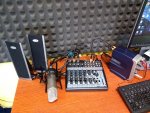Hi everyone! I've been the "sound master" for my company for a couple years now, which means managing recording sessions, editing the audio, and producing CDs. The audio content is entirely spoken dialogue. The CDs are for teachers to use with students learning English as a foreign language, and contain samples of native English speakers having conversations, reading texts, etc.
Up till now we've been using a RODE NT2-A microphone (condenser). We originally had two, but one died over a year ago and we switched to just one. Now the second one is dying as well (getting a lot of weird noises in recordings, quality is degrading, etc.). I've been given permission to purchase two new microphones as replacements, but unfortunately I know very little about the hardware.
The recording studio is unusual and far from ideal. It is just a small closet at one end of the office, where our writers and editors are working at their computers. It is far from soundproof. It has the foam on the walls, but all that does is reduce echo. The current microphone picks up every single tiny little sound in the office, including typing, walking, coughing, etc. One of the most difficult parts of my job is trying to remove the background noises from the recordings. There is no way to stop people from working during these recording sessions. Our voice actors can't come in during the weekends, and deadlines are too tight for people to just not work for a day while we record.
I've therefore been looking at dynamic mics, which I've read pick up much less background noise. This sounds ideal to me. On the other hand, I've also read that they are quieter. Unfortunately, our voice actors are not professionals - they just happen to be the only native English speakers in the area who are available. Some of them shout into the mics. Some of them alternate between shouting and mumbling. Some of them talk so quietly that even with the volume turned all the way up, I have to boost it further in editing to make it properly audible. Will a dynamic mic pick them up properly? Will I need some kind of external amplifier to make the sound audible?
In terms of quality, it's not necessary for it to be particularly high. As long as the dialogue is clear and understandable and free from background noise, it's fine. These CDs are used mostly in classrooms with old, poor-quality CD players. The main concern is that the microphone can pick up our voice actors clearly and without too much background noise.
I'm currently looking at the Audio-Technica ATM610 and the AKG D7 (apparently I can't post links yet because I'm new here), which are both in stock at the shop I'll be purchasing from. Both seem to have good reviews, but again, I just don't know enough about them to know if they're right for our setup.
Any feedback, advice, or ideas are most welcome. Thanks so much for reading my message and thanks in advance for any help.

